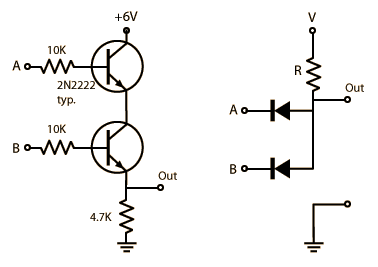You mention:
But I don't understand how current can flow from some signal sources to two transistors to manipulate transistors. There seems no difference of voltage regarding i1 and i2. I want to know the entire circuit diagram including the signal sources.
So, if I understand correctly, you are confused as to how the inputs to the base of the transistors work. I will answer this.
The connection to the base of the transistors are left ambiguous because there are different applications possible to activate each transistor. For instance, you could use manual switches connected to a voltage source or a micro-controller to control the base pins. They are also left ambiguous so the focus is left to the logic of the circuit, and not how it is set up.
However, you were curious as to how such a circuit could be created, so I drew a very primitive example (I assumed you have npn transistors).

simulate this circuit – Schematic created using CircuitLab
This could also be done with a micro-controller as I've mentioned before. You forgot to add R1 in your diagram that you drew, which is very important because otherwise, Vout will be fixed to GND.
When both switches are logic: '1', current flows through R1 and creates a voltage at the R1 node. When either switch is open, the respective transistor becomes inactive. No current will then flow through R1. When no current flows through R1, the voltage drop over the resistor is zero, therefore the voltage at the Vout node is zero.
I hope this helps, however, I'm unsure what you mean by are there 3 separate circuits for i1, i2 and A-B.



